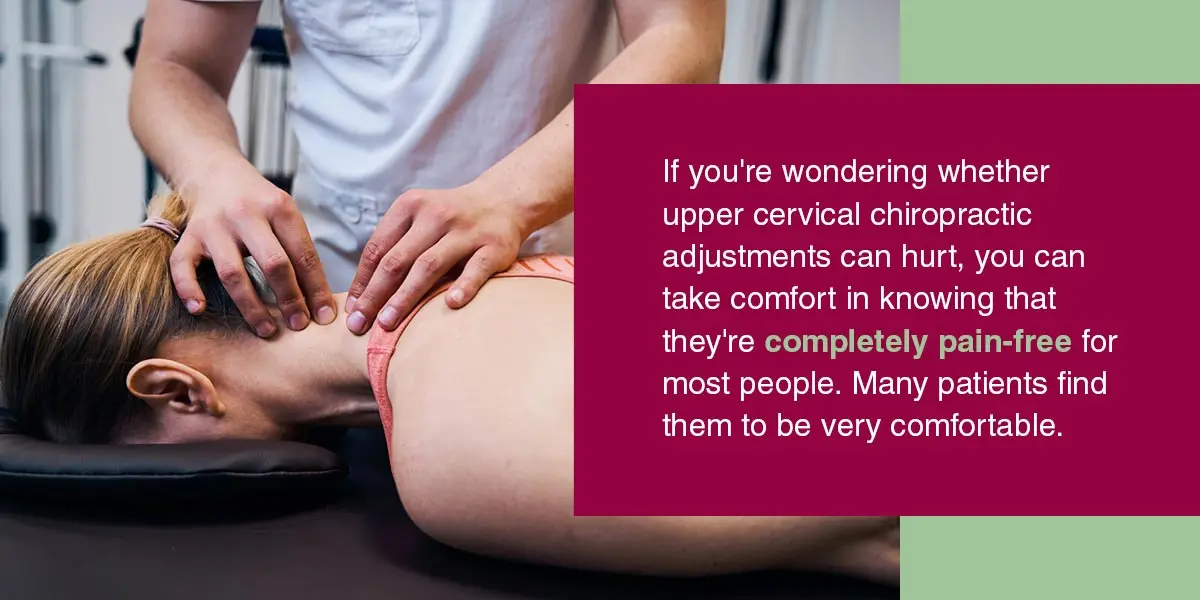Do Chiropractic Adjustments Hurt?

Table of Contents
Is Chiropractic Care Safe?
It’s completely natural to feel cautious or skeptical if you’ve never been to a chiropractor before. Upper cervical chiropractic care can be even more unfamiliar, since it is a specialty practiced by less than an estimated 2% of chiropractors worldwide. Thankfully, we’re here to clear up any uncertainty you may have about chiropractic adjustments, specifically in the upper cervical area.
Are chiropractic adjustments painful? Discover the answer to this and other frequently asked questions regarding upper cervical chiropractic adjustments in this guide.
Do Traditional Chiropractic Methods Hurt?
Most people don’t experience pain during traditional chiropractic adjustments. However, those new to chiropractic care may involuntarily resist the adjustment, stiffen or experience minor discomfort during their first chiropractor visit, especially if they aren’t used to twisting, popping and cracking.
Patients with recent trauma like whiplash may also experience mild discomfort at first. However, spinal adjustments don’t hurt in most cases — they’re more comfortable than painful.
Do Chiropractic Adjustments Feel Good?
Chiropractic adjustments tend to feel good for most people. Many patients encounter a sense of calmness, relief, well-being and improved mobility after their adjustment.
What Is an Upper Cervical Chiropractic Adjustment?
An upper cervical chiropractic adjustment aims to correct spinal subluxation — eventhough the adjustment is delivered through the cervical spine, it impacts the entire spine since the postural control center for the spine is located in the cervical spinal cord. Some Upper Cervical chiropractors use the Quantum Spinal Mechanics (QSM3) approach that focuses a 3-dimensional analysis and spinal correction.
The upper cervical spine plays a crucial bodily role, as it holds the weight of your skull. It’s highly flexible but also more susceptible to misalignment during whiplash, vehicle collisions, falls and sports-related injuries. Misalignments can also occur without trauma from routine daily activities such as poor posture, faulty ergonomics and chronic stress.
Spinal misalignments or subluxations can increase the risk of neurological irritation in the brain stem. Subluxations can also cause abnormal alignment in the cervical spine, significantly affecting the spinal fluid that moves around the skull.
An individual with a subluxation can experience numerous complications, including:
- Neck pain
- Nerve pain
- Vertigo
- Migraines
- Shoulder pain
- Lower back pain
- Temporomandibular joint disorder
- Poor balance and posture
- Post-concussion syndrome
- Meniere’s diseases
- Fibromyalgia
An upper cervical chiropractic adjustment can help relieve pain, improve posture and restore balance to the nervous system and spine. While the correction primarily targets the neck, it also benefits the entire spine and all other bodily systems.

Do Upper Cervical Chiropractic Adjustments Hurt?
If you’re wondering whether upper cervical chiropractic adjustments can hurt, you can take comfort in knowing that they’re completely pain-free for most people. Many patients find them to be very comfortable.
QSM3 doesn’t involve any popping, twisting or cracking of the spine. Because this technique is so gentle, it’s become a common chiropractic approach for seniors, children and patients that previously had spinal surgery.
What Makes Upper Cervical Different From Traditional Chiropractic Methods?
Below are some qualities that differentiate upper cervical chiropractic adjustments from traditional methods.
1. Head and Neck Alignment
As mentioned, upper cervical chiropractors specialize in correcting the entire spine through head and neck area. All brain to body and body to brain communication transmits through the upper cervical region, making this type of chiropractic care essential for overall health. A misalignment of the upper cervical spine can impact the whole body.
2. Precise Corrections
A traditional chiropractor may choose common procedures that twist or pop certain bodily areas to administer spinal adjustments. While conventional chiropractic care works well for many people, others may prefer a gentler approach that doesn’t produce audible popping sounds. Many patients have chronic pain, surgical history Quantum Spinal Mechhanics3 (QSM3) or neurological conditions that require a more delicate approach. The upper cervical spine is highly sensitive and should be handled with the utmost care and precision.
QSM3 is a gentle and appealing option for many patients. Unlike traditional practitioners, who often use more intense alignments, upper cervical chiropractors emphasize accurate corrections to ensure a gentler approach. QSM3 also provides stabilization, meaning the area may require less care over time.
3. Additional Testing
Since a misaligned upper cervical spine can affect other body parts, upper cervical chiropractors typically use additional testing. For example, a practitioner will take standing spinal x-rays (if indicated) to assess biomechanics and spinal jointhealth. They may use neurological technology like Infrared Thermography and Surface Electromyography to identify and track neural patterns and function.
These exams allow upper cervical chiropractors to create a customized plan for each individual, providing the appropriate type of care for their condition.
4. Well-Versed
While upper cervical chiropractors mainly focus on head and neck alignment, many also provide general chiropractic care for their patients. You can think of them as traditional chiropractors with specialized knowledge of the cervical spine.
Are Upper Cervical Chiropractic Adjustments Safe?
Upper cervical spinal adjustments — as well as traditional chiropractic adjustments — are completely safe when performed by highly trained and licensed professionals. Risks and complications are very rare, though some people may experience minor side effects such as muscle soreness, headaches and fatigue after chiropractic adjustments.
What Are the Benefits of Upper Cervical Chiropractic Adjustments?
Below are some advantages of upper cervical chiropractic adjustments.
1. Better Balance and Posture
Misalignment in your upper cervical spine can cause poor posture and balance. In addition to pain relief, an upper cervical chiropractic adjustment can help restore your balance and posture.
2. Improved Mood
Because your mental and physical health influence each other, regular chiropractic adjustments may help relieve stress, depression and anxiety. Research also suggests that upper cervical chiropractic care can improve hormone regulation, increasing norepinephrine and dopamine that elevate the mood.
3. Holistic Approach
Holistic care differs from traditional medicine, focusing on the whole body rather than a specific set of symptoms or a single body part. Upper cervical chiropractic care integrates a holistic approach. It benefits the entire body, addressing the root cause of the pain rather than simply the symptoms.
4. Personalized Care
Your upper cervical chiropractor can specially tailor your care to your unique needs and condition. Your practitioner will discuss your symptoms with you, perform a comprehensive physical examination and order imaging. They’ll take detailed bodily measurements using the images of your cervical spine. You can count on personalized upper cervical care with Upper Cervical Chiropractic of Monmouth, LLC.
Schedule a Consultation at Upper Cervical Care of Monmouth, LLC
If you’re seeking a gentle, precise approach to correct a misalignment in your upper cervical spine, the highly trained team at Upper Cervical Chiropractic of Monmouth, LLC can help. We use the QSM3 approach to help restore function to your central nervous system and brain stem. Using careful diagnostics, we can help locate and address your problem with a customized care plan to relieve your pain, improve balance and correct posture.
Whether you’re experiencing migraines, vertigo, neck pain or another condition, upper cervical chiropractic care may be your solution. Contact us to learn more about our services, or schedule a consultation appointment today!





